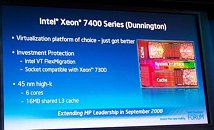
Intel to Detail 8-core Nehalem-EX Processor Next Week
Having successfully established the Nehalem architecture-derived Core i7 series as the industry's fastest consumer processors available, and recently propagating the architecture to two-socket Xeon series for servers and high-end workstations, Intel is set to push up parallelism two-fold with the Nehalem-EX 8-core enterprise processor. The company will detail this new line of chips next week, although a commercial-launch can be expected only in late 2009 or early 2010.
The new chip will succeed the company's own Xeon E7000 "Dunnington" series 6-core processors, for having the highest available parallelism per socket. The 8 physical x86-64 processing cores will further feature HyperThreading technology, sending the logical-processor count to 16 threads per socket. Each processor packs 2.3 billion transistors. The processor will further be designed for systems with more than two sockets per board. Currently although server-builders sell 1U and 2U servers with more than two Nehalem quad-core processors, the system is designed by using two (or more) two-socket mainboards interconnected using Infiniband. The announcement will be made on May 26, in an address headed by Boyd Davis, Intel's general manager of Server Platforms Marketing Group.
The new chip will succeed the company's own Xeon E7000 "Dunnington" series 6-core processors, for having the highest available parallelism per socket. The 8 physical x86-64 processing cores will further feature HyperThreading technology, sending the logical-processor count to 16 threads per socket. Each processor packs 2.3 billion transistors. The processor will further be designed for systems with more than two sockets per board. Currently although server-builders sell 1U and 2U servers with more than two Nehalem quad-core processors, the system is designed by using two (or more) two-socket mainboards interconnected using Infiniband. The announcement will be made on May 26, in an address headed by Boyd Davis, Intel's general manager of Server Platforms Marketing Group.
